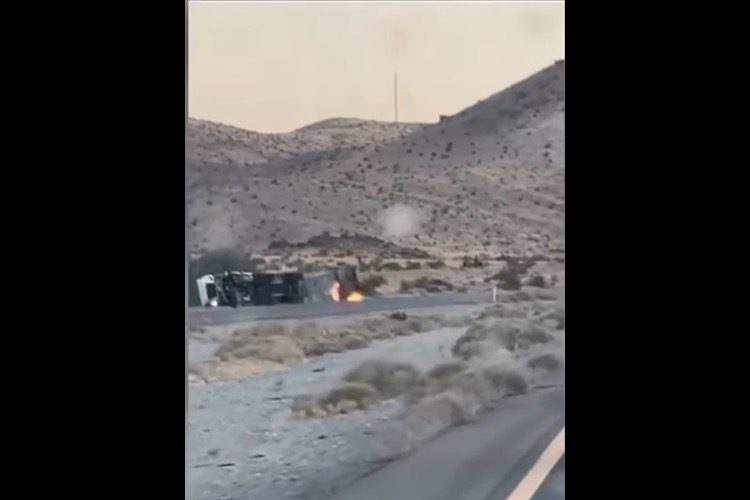
On the morning of July 26, a semi-truck carrying lithium-ion batteries overturned and caught fire on Interstate 15 between Barstow and Baker, California, causing a significant traffic disruption. The highway, a main freeway route between Los Angeles and Las Vegas, was promptly shut down, leaving thousands of motorists stranded in the desert heat.
According to the media reports, the closure and subsequent traffic delays were caused by the overturning of a truck transporting six large commercial lithium-ion batteries, which then caught fire. As a result, both northbound and southbound lanes were closed as firefighters responded to the hazardous blaze. While southbound traffic was eventually allowed to resume, the northbound lanes remained closed for an extended period.
According to the Las Vegas Review Journal,
The crash on Interstate 15 before 8 a.m. Friday created a nightmare for motorists for about 44 hours, with some calling it a “crisis situation” and a “traffic apocalypse from hell.” When drivers trying to avoid the freeway closure headed south to Interstate 40, that freeway also became a parking lot.
The outlet quotes California Highway Patrol Officer Shane Hernandez, who said on Sunday morning that “Thousands upon thousands of commuters headed for Vegas [were] stuck,” estimating that “the I-15 backup was probably 15 miles at some point as heavy Friday afternoon traffic en route to Las Vegas stacked up.”
Social media users posted chilling pictures of the traffic jam.
“Carmageddon!!! Had to turn back from the I40. Having my 4 teenage daughters in the car for 10hrs straight wasn’t the biz,” wrote one of the X users in response to the local report of the traffic catastrophe unfolding in the desert between two big cities, and posting footage of the “carmageddon” traffic jam.
Citizen journalist Ashton Forbes said that the load of batteries was 75,000 lbs, and that the smoke that it produced was toxic.
The amount was confirmed by the San Bernardino County Fire Department, as quoted by The Orange County Register.
The batteries “burned all night, spewing toxic gasses and was still smouldering into Saturday night as officials pondered how to extinguish and remove the wreck,” wrote the Las Vegas Review Journal.
The outlet describes that an unspecified number of motorists sought refuge in hotels in Baker or Barstow or ended up spending the night in their vehicles, enduring temperatures around 100 degrees.
The California Highway Patrol issued the following statement on Saturday night:
We apologize for this inconvenience, but everything that is being done is in the interest of public safety. Due to the location of this incident, alternate routes are slim to none. Units are currently working to see if traffic can begin flowing safely, away from the inhalation hazard zone. Remain patient and safe as first responders and emergency personnel work on this dangerous situation.
The statement also provided that numerous agencies, including the California Highway Patrol, California Department of Transportation, California Department of Emergency Services, Bureau of Land Management, Environmental Protection Agency, and several others, were actively collaborating to clear the still-burning hazardous materials from the roadway.
“Due to the lithium-ion, water cannot be added to the fire, the batteries must burn out on their own,” explained the patrol.
The state was providing the strained drivers with water and gasoline, according to California’s Caltrans District 8.
The fire, which burned for approximately 30 hours, required significant resources to extinguish and prevent reignition, a known risk with lithium-ion batteries.
As reported by the San Bernardino County Fire Department, that included significant manpower, as well as heavy and specialized equipment.
All lanes of the Interstate were open on Sunday, according to the update from the CHP Barstow.
The exact cause of the truck’s overturning is still under investigation, and authorities are working to determine the full extent of the damage.
There were no reported casualties in the incident.
Risks of Lithium-ion Batteries
Lithium-ion batteries are rechargeable batteries using lithium compounds to store and release energy. They are used in a variety of electronic devices, gadgets, and vehicles, including toys, laptops, smartphones, hybrid vehicles, and fully electric cars.
However, lithium-ion batteries are not without risks. One of the most significant dangers associated with these batteries is their potential to catch fire, primarily due to a phenomenon known as thermal runaway. Thermal runaway is a chain reaction that occurs when a battery overheats, leading to the uncontrollable release of energy. This process can be triggered by several factors, including manufacturing defects, physical damage, overcharging, or exposure to high temperatures.
When lithium-ion batteries catch fire, they release a variety of hazardous gases, posing significant health and environmental risks. Notable among these are hydrofluoric acid, carbon monoxide, and hydrogen fluoride. Hydrofluoric acid is highly corrosive and can cause severe respiratory irritation, skin burns, and eye damage upon exposure. Carbon monoxide, a colorless, odorless gas produced during the combustion of the organic solvents in the electrolyte, is toxic and can lead to headaches, dizziness, and even death in high concentrations. Hydrogen fluoride, another highly toxic and corrosive gas, can cause severe respiratory damage and systemic toxicity.
Other dangerous substances released include phosphorus pentafluoride, methane, ethane, and volatile organic compounds such as benzene, toluene, and xylene. These compounds contribute to the fire and explosion risk and can cause long-term health effects such as cancer.
It was reported last year that lithium-ion batteries had been linked to an increase in the number of fire incidents in California.
“Sometimes, these fires set entire apartment blocks ablaze, leading to widespread property damage, injuries, and even fatalities. In other cases, lithium-ion batteries have the potential to start wildfires or fires in residential neighborhoods,” wrote personal-injury law firm Mary Alexander and Associates, P.C., quoting evidence of the recent incidents, such as Tesla cars “spontaneously erupting in flames” and e-bikes suddenly catching fire.



